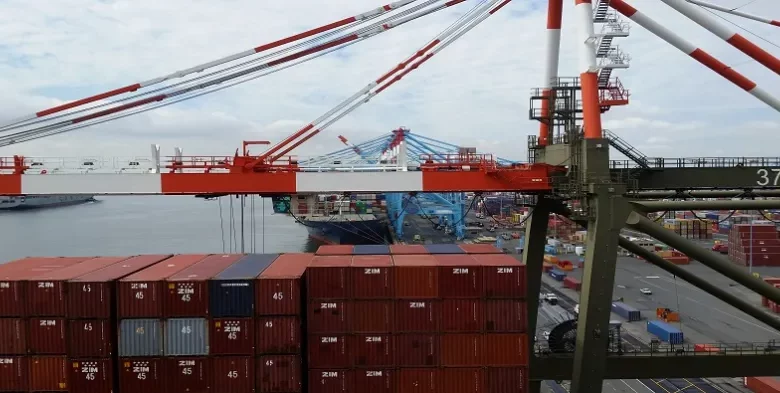
Top 20 Ports with Extensive Connectivity to Global Trade Routes – Global trade has been rapidly expanding over the past few decades, with the total value of global exports more than tripling since 2000. This growth in international trade has been enabled by major ports around the world that serve as critical hubs connecting producers and consumers across vast distances. In this article, we will explore the 20 busiest and most connected ports that facilitate the movement of containerized cargo worldwide.
The importance of these mega-ports stems not only from the sheer volume of cargo they handle, but also their extensive connectivity to global shipping lanes and inland transport networks. Most of these ports have efficient multimodal transport links via rail, roads and rivers, allowing seamless transfer of freight between ships and land. This interconnectivity allows these ports to efficiently distribute and consolidate cargo flows between domestic markets and the rest of the world.Top 20 Ports with Extensive Connectivity to Global Trade Routes
👉 Relocate to Canada Today!
Live, Study and Work in Canada. No Payment is Required! Hurry Now click here to Apply >> Immigrate to CanadaThe list includes ports spread across Asia, Europe, North America and the Middle East. China dominates the list with 7 of the top 10 ports, showcasing its role as the world’s foremost trading nation and manufacturing powerhouse. Many of these top ports have undergone massive expansions in recent years to meet surging trade volumes and are hubs of logistics activity in their regions. Let us explore the world’s 20 most important cargo ports sustaining international supply chains.
Top 20 Ports with Extensive Connectivity to Global Trade Routes
1. Shanghai, China
The Port of Shanghai is the world’s biggest and busiest container port. It handled over 47 million TEU (twenty-foot equivalent units) of container volume in 2021, which is more than the total volume of the next five busiest ports worldwide. Shanghai Port is strategically located at the mouth of the Yangtze River, providing easy access to China’s industrial heartland. It has extensive connections across the Yangtze River Delta through roads, rail and inland waterways. The port serves as the main gateway for China’s imports and exports. Its four main container terminals – Yangshan, Waigaoqiao, Wusong and Baoshan – are all among the top 10 busiest container ports worldwide.
Read Also: Top 15 USDT Marketplaces in Nigeria
2. Singapore
Singapore is located along the Strait of Malacca, one of the busiest shipping lanes in the world, which makes it a critical transshipment hub between East Asia and Europe/Africa. It handled over 37 million TEU of containers in 2021. The Port of Singapore has connections to over 600 ports globally and is linked to inland transportation networks across Southeast Asia. It operates four primary container terminals – Brani, Keppel, Pasir Panjang and Tanjong Pagar. Singapore is renowned for its world-class port infrastructure and high operational efficiency.
3. Ningbo-Zhoushan, China
The Port of Ningbo-Zhoushan in southeastern China has rapidly grown to become the third busiest port for container throughput, handling over 34 million TEU in 2021. Positioned in proximity to Shanghai, it serves as a vital manufacturing and export hub for the Yangtze River Delta. It has excellent connectivity to the region’s dense transportation infrastructure. The port aims to expand its facilities and cargo handling capacity further to become the largest port worldwide by 2025.
4. Shenzhen, China
The Port of Shenzhen is located close to Hong Kong in Guangdong province and serves the densely populated Pearl River Delta region, which is a major Chinese manufacturing base. It handled over 27 million TEU of containers in 2021. The port has extensive terminal facilities integrated with multimodal transport networks across the Pearl River Delta spanning rail, road and inland waterways. It acts as a gateway between mainland China and markets across Asia and the rest of the world.
Read Also: Top 15 Leading Technology Institutions in Nigeria
5. Guangzhou Harbor, China
Guangzhou Port is another vital trading hub for South China located on the Pearl River. It had a container throughput of over 20 million TEU in 2021. The port gives shippers cost-effective access to the Guangdong region’s vast manufacturing base and hinterland networks. It operates four main container terminals – Nansha, Huangpu, Xinsha and Dongpu. Extensive transport links to inland locations have fueled Guangzhou’s rapid growth as a transshipment center.Good morning My Love Message
👉 Relocate to Canada Today!
Live, Study and Work in Canada. No Payment is Required! Hurry Now click here to Apply >> Immigrate to Canada6. Qingdao, China
Qingdao Port on China’s eastern coast handled over 21 million TEU of cargo in 2021. It is one of China’s major connections to seaborne trade with Japan, South Korea and Europe. The port features 35 specialized container berths with modern facilities and equipment. It is also linked by rail to industrial zones across Northeastern China. Qingdao Port’s strategic location and connectivity is instrumental to Chinese manufacturing exports.
7. Busan, South Korea
The Port of Busan is South Korea’s largest port and one of the 100 busiest container ports worldwide, handling 20 million TEU annually. Its geographical location on the southeastern tip of the Korean peninsula provides direct connectivity to global east-west shipping lanes. Busan serves as the primary logistics gateway for South Korea’s booming exports business. It has interconnected rail and road networks to transport containers throughout the country. The port is positioned to benefit further as a transshipment hub between Northeast Asia and the US.
8. Tianjin, China
The Port of Tianjin trades over 18 million TEU per year and serves as the main maritime gateway to China’s capital Beijing and its northern provinces. Located at the intersection of major north-south and east-west shipping lanes in northern China, it acts as a vital transshipment point for cargo to inland provinces. An extensive network of ports, rail, roads and pipelines links the Port of Tianjin to industrial and logistics zones across the Beijing-Tianjin-Hebei region.Information guide Nigeria
Read Also: Top 15 AirPods Models in Nigeria
9. Rotterdam, Netherlands
The Port of Rotterdam on the North Sea coast of the Netherlands is Europe’s largest cargo port. Over 14 million TEU of containerized cargo passed through Rotterdam in 2021. Its location provides connectivity to the dense industrial and population centers of the European continent. Extensive inland waterways, rail, road and pipeline connections enable efficient freight distribution across the Netherlands and mainland Europe. The Port of Rotterdam is undertaking major logistics park developments to strengthen its position as a leading European cargo hub.
10. Dubai, UAE
Dubai has emerged as a major trading crossroads between East and West. Its strategic location has enabled Dubai to become a leading logistics hub for the Middle East, Africa, and South Asia. The Port of Dubai handled over 14 million TEU of cargo in 2021. It offers connectivity to over 180 shipping lanes worldwide across its two main facilities at Jebel Ali and Port Rashid. Seamless air-sea cargo integration has made Dubai a vital global hub for just-in-time logistics and supply chains. Extensive transport links enable swift cargo flows across the UAE and wider region.NYSC Portal
11. Hong Kong, China
Despite its small geographic size, Hong Kong’s natural deep-water harbor has enabled it to become a leading Asian cargo hub. Hong Kong handled over 13 million TEU in 2021. The port connects to over 500 destinations worldwide and provides excellent connectivity to mainland China’s industrial centers across the Pearl River Delta. Hong Kong will continue to serve as a critical Asian transshipment port and logistics center despite recent challenges.
12. Antwerp, Belgium
The Port of Antwerp in Belgium is a vital maritime gateway to Europe, handling over 12 million TEU of containers annually. The port’s prime location near the mouth of Europe’s second-longest river, the Scheldt, provides connectivity to key industrial regions in Belgium, the Netherlands, Germany and France. Antwerp is Europe’s second largest container port, offering integrated road, rail and inland shipping connections to inland destinations. Ongoing expansion efforts aim to boost Antwerp’s capacity and competitiveness as a European cargo hub.Romantic love message
Read Also: Top 15 Nigerian Actresses to Watch in 2023
13. Los Angeles, USA
The Port of Los Angeles in California is North America’s largest container port facility. It handled 10.7 million TEU of cargo in 2021. Positioned near the entry point of the Trans-Pacific trade lane, it provides vital connectivity between mainland US consumers and East Asian exporters. An extensive network of major US railroads and highways radiate out from Los Angeles to facilitate domestic container distribution. It is undertaking major infrastructure projects to handle larger vessels and cargo volumes as a core US maritime trade gateway.
14. Long Beach, USA
Neighboring the Port of Los Angeles is the Port of Long Beach – which combined make up the San Pedro Bay Port Complex that accounts for over 40% of all US imports. Long Beach handled over 9 million TEU of cargo in 2021. It primarily handles inbound freight from China and coordinates closely with LA Port to facilitate cargo flows across Southern California. Investments into new facilities, terminals and rail links have boosted Long Beach’s role as a core US maritime trade portal.
15. Hamburg, Germany
The Port of Hamburg on Germany’s Elbe River has a storied history as a Hanseatic League trading center. Today, Hamburg handles over 9 million TEU of containers annually, functioning as Germany’s premier maritime gateway. Since over 90% of Germany’s foreign trade is conducted through seaports, Hamburg is vital for the country’s global trade connectivity. Its inland waterway, road and rail links provide access to industrial zones across Germany and Central Europe, complementing its role as a North Sea container hub.JAMB portal
Read Also: Top 15 Nigerian Instagram Marketing Consultants in Nigeria
16. Tanjung Pelepas, Malaysia
Malaysia’s Port of Tanjung Pelepas has emerged as a major regional transshipment hub, handling over 9 million TEU annually. Its position along the Strait of Malacca provides strategic access to busy East-West trade lanes. The port has excellent connectivity to inland transport networks across Malaysia’s peninsular, facilitating domestic trade distribution. Cost-effective operations and seamless multimodal transport links have enabled Tanjung Pelepas to become a preferred Southeast Asian hub for many global liners and shippers.
17. Laem Chabang, Thailand
Serving as Thailand’s primary deep-sea port, Laem Chabang Port handled 7.1 million TEU of cargo in 2021. Located near the country’s eastern seaboard industrial zones, it is a gateway for Thailand’s exports and connects to over 200 global destinations. The port has six primary container terminals with extensive transportation links spanning inland waterways, roads, rail and air. Laem Chabang is equidistant between Singapore and Hong Kong, boosting its competitiveness as a Southeast Asian transshipment hub.
18. New York / New Jersey, USA
The Port of New York & New Jersey is the largest port on the US East Coast, handling over 6 million TEU annually. Its location near the mouth of the Hudson River into New York City provides vital connectivity to one of the most densely populated consumer markets in North America. With 90% of goods consumed in New York arriving by sea, the port is integral to regional supply chains. Recent expansion projects have boosted capacity, enabling the port to handle larger container ships and cargo volumes.
19. Kaohsiung, Taiwan
Taiwan’s largest port, the Port of Kaohsiung handled over 5.6 million TEU of containers in 2021. Positioned on the southwest coast of Taiwan, Kaohsiung is the country’s main hub for exports and transshipments. The port integrates both sea and air freight infrastructure, with regular feeder and direct services to ports across Asia, Europe and the US. Recent efforts have focused on boosting intermodal transport integration and digitalization to strengthen Kaohsiung’s hub status.
20. Shenzhen, Taiwan
Rounding off the list is the Port of Shenzhen in Taiwan, which handled around 5.5 million TEU of containers in 2021. Located strategically near the mouth of the Pearl River facing China, it serves as Taiwan’s primary international trading gateway. It operates two main container terminals which connect Taiwan to over 150 international destinations. Shenzhen Port provides important connectivity to the vibrant manufacturing zones and export processing industries located across Taiwan.
Conclusion
In summary, these top 20 global ports fulfill a vital role in enabling the seamless movement of international trade and driving global economic growth. The list reflects how the center of gravity in maritime trade has shifted towards Asian mega-ports, showcasing the region’s dominance in manufacturing exports and containerized supply chains. Global liners depend on these efficient interconnected hub ports to consolidate and distribute cargo between crowded trade lanes reliably. As trade continues growing in volume and complexity, these top ports must continue boosting capacity, infrastructure and operational excellence to sustain modern supply chains. The future competitiveness of nations across the world will depend on having well-equipped major ports to participate in global commerce.
Check JAMB RESULT
Check and Confirm: How much is Dollar to Naira







